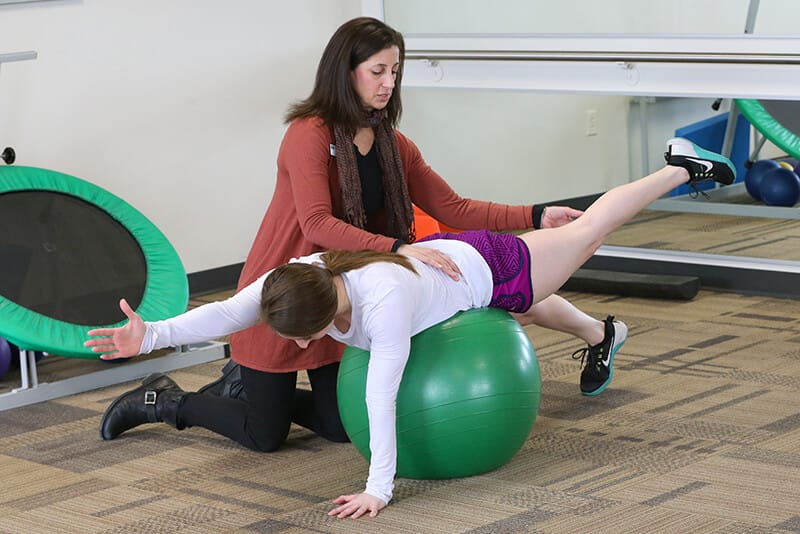It’s good for kids to participate in sports and activities. It helps them develop physical fitness, improve coordination, learn self-discipline and appreciate the value of teamwork.
But children are near the bottom of the learning curve. They’re figuring out how to grow into their still-developing bodies while, at the same time, figuring out the techniques and fitness required in their preferred sports. Because of this, kids can be at risk for injuries.
Sports injury is the most common reason for physical therapy in young athletes.
Kids bounce back more quickly than adults, but it’s still difficult to overcome a serious injury without the help of a physical therapist. Even minor sprains and strains can mean a muscle imbalance, functional issue or lack of mobility that should be corrected to prevent further injury once activity resumes.
So physical therapy has benefits on both sides of a sports injury, helping children recover from them or prevent them in the first place. And you don’t have to wait for a referral to bring your child in for any of these common sports injuries.
Concerned About Your Child?
Any sign your child is injured or their movement is impaired may require physical therapy.
1. Strains, Sprains and Bruises
You see them more in contact sports. But muscle strains, ligament sprains and bruises can happen in any type of activity. These acute injuries lead to swelling, limited mobility and pain, which may not go away on their own.
Things like hamstring strains, ankle sprains or bone bruises on the knee are all helped by a little PT. Manual therapy can help restore normal range of motion and reduce swelling. Therapeutic exercise and neuromuscular re-education help children regain normal strength, balance and movements patterns. This paves the way for a full return to activity without limitations and decreases the risk of re-injury.
2. Overuse Injuries
An overuse injury occurs gradually over time due to imbalances in the body after doing repetitive motions. Tendonitis, bursitis and other overuse injuries are common in the era of sports specialization. The year-round focus on one sport means young athletes are repeating the same motion — like throwing a baseball — much, much more.
Rest and a brace can help but the injury can crop up as soon as your child starts playing again. Physical therapy plays an important role in overcoming the recurring pain and inflammation, restoring normal range of motion and building the strength and body mechanics needed for a full return to activity.
3. Broken Bones and Fractures
A hard fall can mean your child will spend the next few weeks in a cast or brace. It’s often necessary to immobilize the bones, giving them time to heal properly. You might think your child is all healed after getting a cast or splint removed. While weeks of immobility help the bone, it can cause the joints to grow stiff and the muscles weak.
In children, this can resolve on its own. But there’s no telling how long it will take for everything to return to pre-injury levels. Oftentimes, the tendons, ligaments and muscles surrounding the bone need more than rest to heal up and regain function. Strengthening and range of motion exercises can help kids regain full mobility and strength to resume the activities that led to the injury — and help prevent injury to the muscles, tendons, ligaments and joints.
4. Concussions
Although they occur most often on the football field, head injuries can happen in other sports. A hard fall in hockey or run-in with an opponent in soccer can just as easily cause a concussion.
Concussions are mild traumatic brain injuries and should be taken seriously. Symptoms like headache, dizziness, nausea and fatigue can linger and limit even daily activities. Nobody, a child especially, should return to high-level activity until concussion symptoms subside. In partnership with your family physician or pediatrician, a physical therapist can evaluate and monitor your child’s symptoms and put them on a path for a gradual return to activity.
Even physical therapy can’t start until concussion symptoms allow. Once baseline symptoms have improved, PT helps kids train for sport-specific movements. It could be faster head movements, a progression from light jogging to running or dynamic exercises to restore balance. These exercises can help your child fully recover after a blow to the head and give you the confidence that they’re ready to return to play.
When does my child need physical therapy?
Injuries are bound to happen to active children. Each year, more than 2.6 million kids show up to the ER with a sports injury. More often than not, those injuries occur in practice and out of sight of supporting parents.
You can’t always be there to know when an injury occurred but you can ensure your child gets the help they need to recover after they get hurt. And that often means a call to your physical therapist.
Strains, sprains, overuse injuries and broken bones can happen anywhere in the body. No matter the injury or age of your child, physical therapy may be just the thing your kid needs. From dry needling to taping to manual therapy, a physical therapist has a variety of tools for treatment.
Preventing injury is just as important as recovering from one. If your child has frequently-occurring issues like foot pain, ankle sprains or knee soreness — or just needs some sport-specific exercise program to prep for the next season — a physical therapist can help.
Injuries or not, if you’re concerned about the toll youth sports is taking on your child’s body, talk to a physical therapist about keeping your kid healthy and active.


